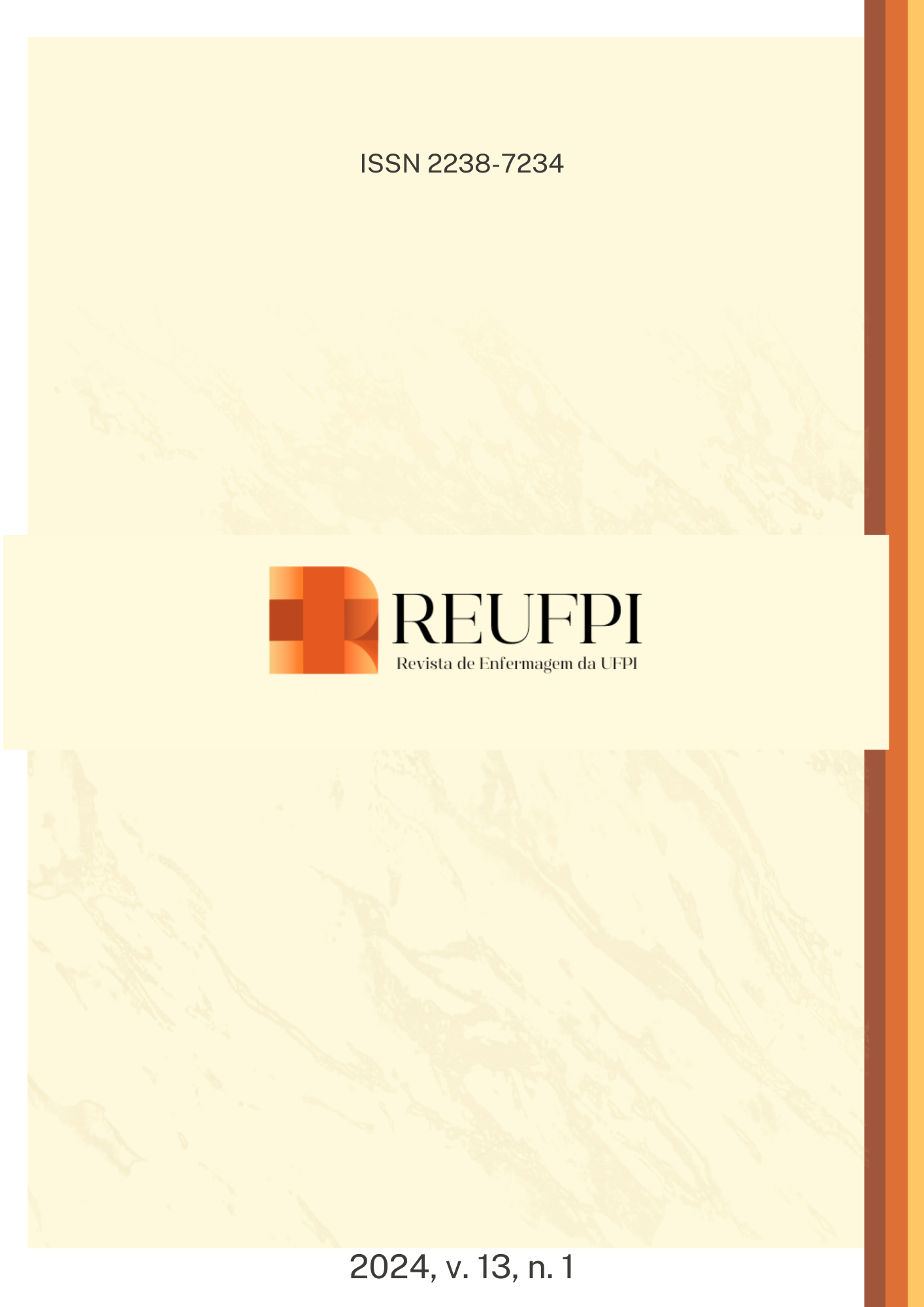Reduction in life activities after hospitalization for COVID-19 in intensive care units
DOI:
https://doi.org/10.26694/reufpi.v13i1.4151Keywords:
Intensive Care Units, Activities of Daily Living, Sars-CoV-2. Ansiedade. Equipe de Enfermagem, COVID-19Abstract
Objective: To verify the factors associated with reduction in life activities in patients 12 months after discharge from the COVID-19 ICU. Methods: This is a cross-sectional, analytical study with a quantitative approach, based on primary data from patients at the Hospital Universitário Regional dos Campos Gerais, Paraná, Brazil. The final sample consisted of 32 patients discharged from the ICU between March 2020 and March 2021. Results: There was statistical evidence of a difference between the means of the groups in the domains Life Activities (p= 0.0001) and Disability (p< 0.0001), confirming that the disabled group has a worse indicator of disability in this domain; as also occurs between the geometric means of the groups. Conclusion: The most prevalent factors associated with reduction in life activities were those involving the physical and psychological domains, directly influencing their recovery. In addition, future research could focus on specific intervention strategies to minimize the impact of these sequelae and improve rehabilitation in COVID-19 patients.
References
Pinto MR, Santos MER, Lopes GS. Covid-19: health injuries for the elderly population. Braz J Dev. [Internet]. 2022;8(6):44691-710. DOI: https://doi.org/:10.34117/bjdv8n6-138
Lima FHS, dos Santos RDA, Silva HGL, Machado RPMSP, de Almeida AM, Reis DPS, et al. COVID-19: Origin, Impacts and Health Prevention in Rondonia, Western Amazonia, Brazil. SAJ Basic Educ Tech Technol. [Internet]. 2022;9(1):310-25. Available from: https://periodicos.ufac.br/index.php/SAJEBTT/article/view/4354/4068
Silva CDLN, Rodrigues MB, Miura CRM. Physical manifestations of the Post Intensive Care Syndrome and the survivor's functionality: an integrative review. BJHR. [Internet]. 2021; 4(4):17311-28. DOI: https://doi.org/:10.34119/bjhrv4n4-229
Teixeira GA, Dantas DNA, Carvalho GAFDL, Silva AND, Lira ALBDC, Enders BC. Análise do conceito síndrome congênita pelo Zika vírus. Ciência & Saúde Coletiva. [Internet] 2020; 25:567-74. DOI: https://doi.org/10.1590/1413-81232020252.30002017
Kramer C. Intensive care unit–acquired weakness. Neurol Clin. [Internet]. 2017; 35(4):723-36. DOI: https://doi.org/10.1016/j.ncl.2017.06.008
Barbosa F, Figueiredo P, Mesquita ACNM, Pestana H. Fadiga na pessoa com sequelas da COVID-19, uma proposta de reabilitação: Estudo de Caso. Rev Port Enf Reab. [Internet]. 2022; 5(1):40-50. doi; https://doi.org/10.33194/rper.2022.185
Freitas ARR, Napimoga M, Donalisio MR. Assessing the severity of COVID-19. Epidemiol serv saude. [Internet]. 2020; 29:e2020119. DOI: https://doi.org/10.5123/S1679-49742020000200008
Noor AU, Maqbool F, Bhatti ZA, Khan AU. Epidemiology of CoViD-19 Pandemic: Recovery and mortality ratio around the globe. Pak J Med Sci. [Internet]. 2020; 36(COVID19-S4):S79. DOI: https://doi.org/10.12669/pjms.36.COVID19-S4.2660
Peghin M, Palese A, Venturini M, De Martino M, Gerussi V, Graziano E, et al. Post-COVID-19 symptoms 6 months after acute infection among hospitalized and non-hospitalized patients. Clin Microbiol Infect. [Internet]. 2021; 27(10):1507-13. DOI: https://doi.org/10.1016/j.cmi.2021.05.033
Organização Mundial da Saúde (OMS). East respiratory syndrome coronavirus 2019 (SARS-CoV-2). 2020. DOI: http://www.who.int/emergencies/mers-cov/en/
Aguiar LMM, Martins GDS, Valduga R, Gerez AP, Carmo ECD, Cunha KDC, et al.Profile of adult intensive care units in Brazil: systematic review of observational studies. Rev Bras Ter Intensiva.[Internet]. 2022; 33:624-34. DOI: https://doi.org/10.5935/0103-507X.20210088
Gastaldi AC. Physical therapy and the challenges of Covid-19. Fisioter Pesqui. [Internet]. 2021;28:1-2. DOI: https://doi.org/10.1590/1809-2950/00000028012021
Lima BSS, Gomes ACR, Santos MEA, Gripp MR, Lima VP. Resultados do Perfil do Uso de Antibióticos em UTI COVIC, UTI Não COVID e Enfermaria Covid pelo Método de Análise de Ponto de Prevalência Durante o Ano de 2020. The Braz J Infect Dis. [Internet]. 2022; 26:102431. DOI: https://doi.org/10.1016/j.bjid.2022.102431
Bragatto MG, Almeida BM, Sousa GC, Silva GA, Pessoa LDSG, Silva LK, et al. Study of neuroanatomical sequelae associated with Post COVID-19 Syndrome. REAS. [Internet]. 2021; 13(12):e8759. DOI: https://doi.org/10.25248/reas.e8759.2021
Costa A, Silva-Pinto A. Neurological Manifestations and COVID-19. Acta Med Port. [Internet]. 2020; 33(12):787-8. DOI: https://doi.org/10.20344/amp.14773
Aguiar BF, Lind J, Pasquini-Netto H, Böger B, Abatti RTB, Ramos MP, et al. An integrative review of sequelae of COVID-19. Rev Bras Promoç Saúde. [Internet]. 2022; 35:11. DOI: https://doi.org/10.5020/18061230.2022.12606
Tassara IG, Okabayashi NYT, Casaca MCG, Veronez FS. Prevalência de sintomas psicológicos em tempos de isolamento social. BJHR. [Internet]. 2021; 4(1):1295-309.DOI: https://doi.org/1034119/bjhrv4n1-112
Xiong Q, Xu M, Li J, Liu Y, Zhang J, Xu Y, et al. Clinical sequelae of COVID-19 survivors in Wuhan, China: a single-centre longitudinal study. CMI. [Internet]. 2021; 27(1):89-95. DOI: https://doi.org/10.1016/j.cmi.2020.09.023
Campos MR, Schramm JMDA, Emmerick ICM, Rodrigues JM, Avelar FGD, Pimentel TG.Burden of disease from COVID-19 and its acute and chronic complications: reflections on measurement (DALYs) and prospects for the Brazilian Unified National Health System. Cad Saúde Pública. [Internet]. 2020; 36. DOI: https://doi.org/10.1590/0102-311X00148920
Downloads
Published
How to Cite
Issue
Section
License
Copyright (c) 2024 Rev Enferm UFPI

This work is licensed under a Creative Commons Attribution 4.0 International License.
Autores mantém os direitos autorais e concedem à REUFPI o direito de primeira publicação, com o trabalho licenciado sob a Licença Creative Commons Attibution BY 4.0 que permite o compartilhamento do trabalho com reconhecimento da autoria e publicação inicial nesta revista.






